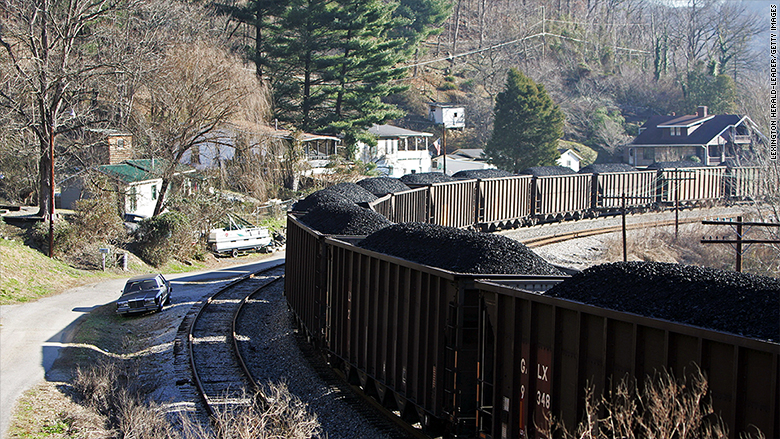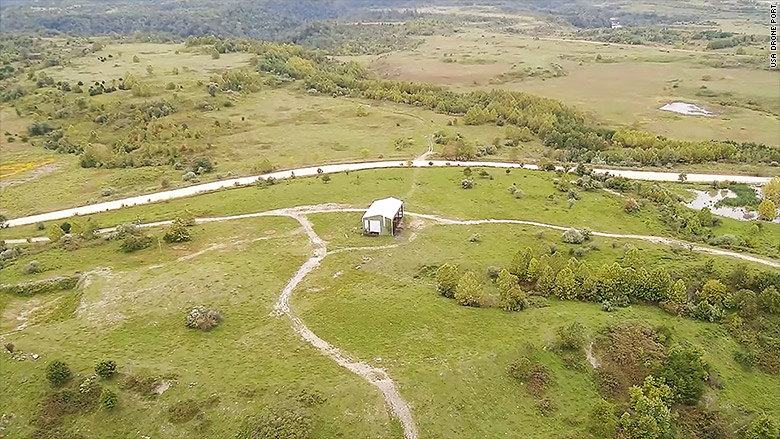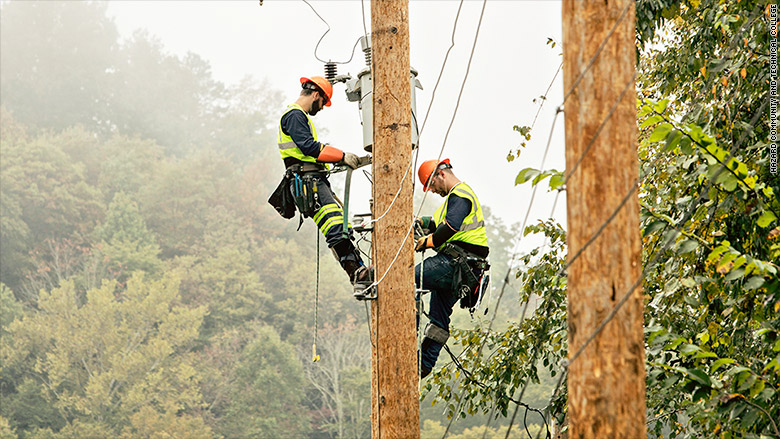
It's a bittersweet celebration.
For the past 40 years, Hazard, Kentucky, has thrown its annual Black Gold Festival to commemorate its decades-long history as a coal mining town.
This year's festival, held in September, featured a parade, musicians, a shooting gallery and even a display of toy coal trucks built by local elementary school students.
But the festivities couldn't hide the starker reality: The area's coal mines have been shutting one-by-one for years, forcing many of the town's residents into joblessness or to look for work elsewhere.
Since 2010, the number of residents in Hazard has shrunk 3.6% to roughly 5,300 in 2016. At the same time, the town has been gripped by the growing opioid crisis.
"One of the pastors in a church here said he kept seeing pews empty out because people stopped coming or moved away," said Tonita Goodwin, director of Hazard-Perry County Economic Development Alliance.
Unemployment in Perry County, where Hazard is located, now stands at 7.3%. That's slightly improved from last year, but still nearly twice the national rate. At its peak in January 2013, the county's unemployment rate soared to 15%.
Related: In a small Kentucky coal town, joblessness leads to a health crisis
"While Perry County's unemployment rate [has] decreased, it is not because the employment situation improved," said Mike Clark, the associate director of the Center for Business and Economics at the University of Kentucky. "While there are fewer people unemployed, there are also fewer people working. Overall, Perry County's labor force has decreased."

Retraining former miners and attracting new employers are essential to revitalizing Hazard's economy -- and time is of the essence, said Jennifer Lindon, president and CEO of Hazard Community and Technical College.
"We're fighting the addiction battle and at the same time trying very hard to bring hope to people here and get them employed again," she said.
'Sitting on a labor gold mine'
Hazard's community is 90% white, with an average annual per capita income of $24,657 -- roughly half the national median. More than a quarter of Hazard's population lives in poverty.
In the last presidential election, 77.2% of Perry County voted for Donald Trump, who campaigned on a promise of bringing coal jobs back, among other things. But while some coal mining still goes on here, there's little hope for its resurgence.
Related: The first coal bankruptcy of the Trump era
"We must diversify Hazard's economy so the whole area isn't devastated when one industry dies," said Lindon.

"In Appalachian communities, families resist leaving their towns, no matter how difficult things get," said Goodwin. "They would much rather jobs come to them."
Economic development groups in Perry County recently conducted a study and discovered that the former coal miners' skills in areas like hydraulics, mechanics and electrical engineering -- would be well-suited for other industries.
"Their skills can easily be transferred to aerospace and other manufacturing, for instance," said Kathy Walker, director of the HAAS eKentucky Advanced Manufacturing Institute in Paintsville, Kentucky. "We're potentially sitting on a labor gold mine here."
Last year, more than a third of Kentucky's total exports were aerospace products and parts, like civilian aircraft, engines and aircraft landing and braking systems.
The state now has 80 aerospace facilities, employing close to 17,000 people, according to a report by the Kentucky Cabinet for Economic Development. Among the top employers in the field are Lockheed Martin (LMT), Safran Landing Systems and Meggitt Aircraft Braking Systems.
Related: These high schoolers are manufacturing airplane parts
In 2008, the state introduced the Kentucky Business Incentives program, which offers a tax incentive to companies that meet targets for job creation and hourly wages, said Jack Mazurak, communications director with the Kentucky Cabinet for Economic Development.
Recently, metal companies in steel, brass and other finished products that require advanced manufacturing skills have started setting up shop in the state, he said.
"Advanced manufacturing is another big area to boost in the state and we're finding ways to retrain coal miners with tech skills, like coding, to prepare them for high-tech software development jobs," Mazurak said.
In November, the institute in Paintsville, an hour away from Hazard, launched a 16-week program to retrain up to 300 displaced workers in eastern Kentucky over the next year. The course trains students for positions such as a CNC (computer numerical control) machinist and as machine building and tool maintenance technicians in the aerospace and advanced manufacturing industries.

Hoping the drone industry takes flight
The town of Hazard is also embarking on its own efforts to attract a new wave of employers. It is turning the site of a former surface mine into USA Drone Port -- a research and testing facility for drone companies to use. The facility, which is set to open in 12 to 18 months, is expected to be 20,000 square-feet and five stories high. There's also a plan to open an indoor drone testing facility in Hazard in a few months.
To provide a local workforce for the drone port, the Hazard Community and Technical College introduced a course in unmanned technology. The course debuted in June and has already graduated 200 students in areas such as drone flight, photography and videography. Several of the students are former coal miners.
That's just one of 17 programs geared toward retraining former coal workers offered at the college. Others include welding and construction. One of the most successful programs is the 12-week electrical lineman course, which has a 90% job placement rate. Starting pay for lineman jobs in Hazard range from $18 to $22 an hour.
So far, 168 former miners have completed the course, said Lindon.
Kentucky Power Co., based in Ashland, Kentucky, serves 168,000 customers in eastern Kentucky and employs 220 workers throughout the state. Matthew Satterwhite, the utility's president and chief operating officer, said he is keenly aware of how much unemployed talent there is in the area.

His firm has provided economic development grants to both Hazard Community and Technical College and the HAAS eKentucky Advanced Manufacturing Institute to support programs that teach coal miners new skills.
Kentucky Power has already hired two former coal miners as linemen so far.
"You may say the accent is funny. But people here can tear apart a car and put it together perfectly in 30 minutes," said Satterwhite. "The biggest cash crop here is the people."


